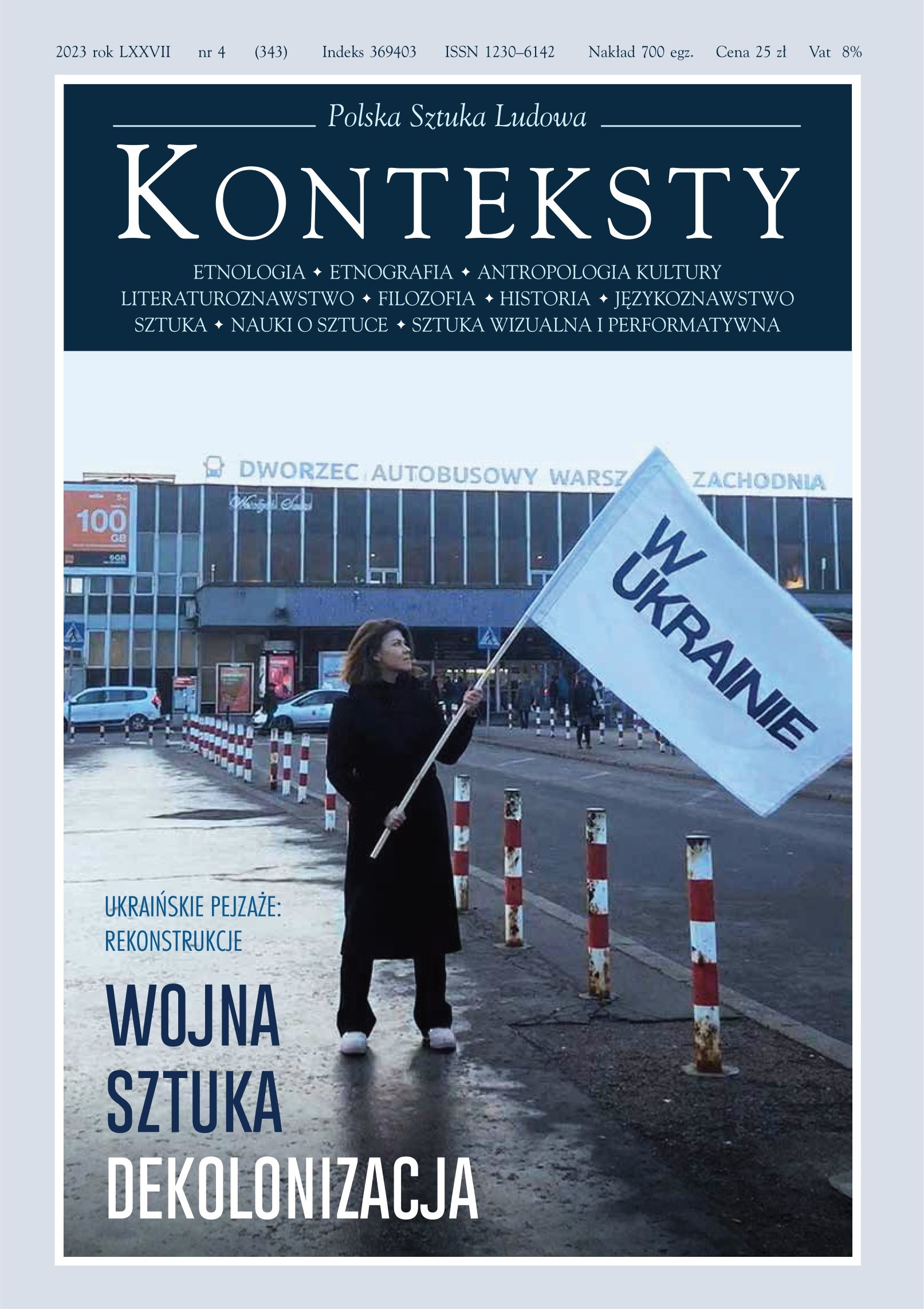Roman anti-landscape
Mateusz Salwa
mateusz.salwa@uw.edu.plWydział Filozofii, Uniwersytet Warszawski (Poland)
https://orcid.org/0000-0003-4988-8912
Abstract
The intention of this article is to show how a traditional aesthetic comprehension of the landscape results in overlooking landscapes regarded as degraded. Such an approach appears to dominate contemporary perceptions of Italy, resulting in their depiction as Bel Paese, whose panorama is sometimes disturbed by ugly sites. In turn, unsightliness is regarded as the outcome of, i.a. a lack of sensitivity on the part of the inhabitants. Such an omission, however, is an act of injustice. The article‘s substance is a confrontation of a vision of Rome as seen by Georg Simmel and a depiction of the Eternal City in the documentary film Sacro GRA (2013); the director presents the daily life of the residents of the region of an extensive Roman urban highway, which can be easily described as anti-landscape. Such a confrontation also serves a depiction, based on selected examples, of the way in which the comprehension of the landscape in Italian literature from the second half of the twentieth century changed: by acquiring an ethical dimension the landscape ceased to be an exclusively aesthetic phenomenon.
Keywords:
Rome, lanscape, anthropology, cityReferences
Assunto Rosario, Il paesaggio e l’estetica, Palermo, Il Novecento, 1973.
Google Scholar
Bassetti Nicolò, Mateucci Sapo, Sacro romano Gra. Persone, luoghi, paesaggi lungo il Grande Raccordo Anulare, con uno scritto di Renato Nicolini, postfazione di Granfranco Rosi, Macerata, Quodlibet 2013.
Google Scholar
Bonesio Lusia, Luoghi e forme, w: Paesaggio. L’anima dei luoghi, a cura di L. Bonesio, L. Micotti, Reggio Emilia, Diabasis, 2008, s. 72-85.
Google Scholar
Brizio‐Skov Flavia, Laviosa Flavia, Marcus Millicent, O’Leary Alan, Riva Massimo, Verdicchio Pasquale, Wagstaff Christopher, Forum: The Present State and Likely Prospects of Italian Cinema and Cinema Studies, w: A Companion to Italian Cinema, Oxford, Wiley-Blackwell, 2017, s. 553-571.
Google Scholar
Camporesi Piero, Le belle contrade. Nascita del paesaggio italiano, Milano, Garzanti, 1992.
Google Scholar
Cresswell Tim, Landscape and the Obliteration of Practice, w: Handbook of Cultural Geography, eds. Kay Anderson, Mona Domosh, Steve Pile, Nigel Thrift, London, Sage, 2003, s. 269-281.
DOI: https://doi.org/10.4135/9781848608252.n18
Google Scholar
D’Angelo Paolo, Filosofia del paesaggio, Roma, Quodlibet, 2010.
Google Scholar
De Martino Roccardo, La poesia dell’ombra. La città e il suo riflesso oscuro, w: La Città altra. Storia e immagine della diversità urbana: luoghi e paesaggi dei privilegi e del benessere, dell’isolamento, del disagio, della multiculturalità, red. Francesca Capano, Maria Ines Pascariello, Massimo Visone, Napoli, Federico II University Press, 2018, s. 915-922.
Google Scholar
Franceschi Cathérine, Du mot paysage et de ses équivalents dans cinq langues européennes, w: Les Enjeux du paysage, sous la dir. de Michel Collot, Ousia, Bruxelles 1997, s. 75-111.
Google Scholar
Ingold Tim, Czasowość krajobrazu, przeł. Beata Frydryczak, w: Krajobrazy. Antologia, red. Beata Frydryczak, Dorota Angutek, Wydawnictwo PTPN, Poznań 2014, s. 141–164.
Google Scholar
Lingiardi Vittorio, Mindscapes. Psiche nel paesaggio, Milano, Raffaello Cortina Editore, 2017.
Google Scholar
Milani Raffaele, L’arte del paesaggio, Bologna, Il Mulino, 2017.
Google Scholar
Modena Letizia, Senza raccontarli i luoghi non esistono”: Il GRA di Roma tra urbanistica e transmedia storytelling, „Forum Italicum”,2016, t. 50(1), s. 194–221.
DOI: https://doi.org/10.1177/0014585816637068
Google Scholar
Olwig Kenneth R., Recovering the Substantive Nature of Landscape, w: tegoż, The Meanings of Landscapes. Essays on Place, Space, Environment and Justice, Routledge, New York 2019, s. 18-49.
DOI: https://doi.org/10.4324/9781351053532-2
Google Scholar
Petrarka Francesco, Do Dionigego da Borgo San Sepolcro, augstianina i profesora Pisma Świętego. O swoich troskach, w: tegoż, Pisma podróżnicze, przeł. i oprac. Włodzimierz Olszaniec, Warszawa, WUW, 2009, s. 43-59.
Google Scholar
Plit Florian, Krajobrazy kulturowe w geografii polskiej. Szkice, Dialog, Warszawa 2016.
Google Scholar
Ritter Joachim, Krajobraz. O postawie estetycznej w nowoczesnym społeczeństwie, przeł. Czesława Piecuch, w: Szkoła Rittera. Studia z filozofii niemieckiej, t. 2, red. Stanisław Czerniak, Jarosław Rolewski, Toruń 1996, s. 45–66.
Google Scholar
Sereni Emilio, Storia del paesaggio agrario italiano, Roma, Laterza 2020.
Google Scholar
Settis Salvatore, Paesaggio, Costituzione, Cemento. La battaglia per ambiente contro il degrado civile, Torino, Einaudi, 2012.
DOI: https://doi.org/10.5070/C321009026
Google Scholar
Simmel G., Most i drzwi. Wybór esejów, przeł. M. Łukaszewicz, Oficyna Naukowa, Warszawa 2006.
Google Scholar
Tosco Carlo, Il paesaggio come storia, Bologna, Il Mulino, 2007.
Google Scholar
Turri Eugenio, Antropologia del paesaggio, Venezia, Marsilio Editori, 2008.
Google Scholar
Urry John, Spojrzenie turysty, przeł. Alina Szulżycka, Warszawa, PWN 2007.
Google Scholar
Venturi Ferriolo Maurizio, Etiche del paesaggio: il progetto del mondo umano, Roma, Editori uniti, 2002.
Google Scholar
Vitta Maurizio, Il paesaggio. Una storia fra natura e architettura, Torino, Einaudi, 2005.
Google Scholar
Sacro Gra, reż. Gianfranco Rosi, Włochy, 2013.
Google Scholar
Authors
Mateusz Salwamateusz.salwa@uw.edu.pl
Wydział Filozofii, Uniwersytet Warszawski Poland
https://orcid.org/0000-0003-4988-8912
Dr hab. Mateusz Salwa - adiunkt, kierownik Zakładu Estetyki na Wydziale Filozofii Uniwersytetu Warszawskiego; zajmuje się współczesną estetyką, ze szczególnym uwzględnieniem problematyki reprezentacji oraz relacji między sztuką a przyrodą; opublikował m.in. Estetyka ogrodu. Między sztuką a ekologią (2016), Iluzja w malarstwie. Próba filozoficznej interpretacji (2010); publikował także w "Etyce", "Kulturze Współczesnej", "Przeglądzie Kulturoznawczym".
Statistics
Abstract views: 280PDF downloads: 218
License
Copyright (c) 2024 Mateusz Salwa

This work is licensed under a Creative Commons Attribution-NonCommercial-NoDerivatives 4.0 International License.







